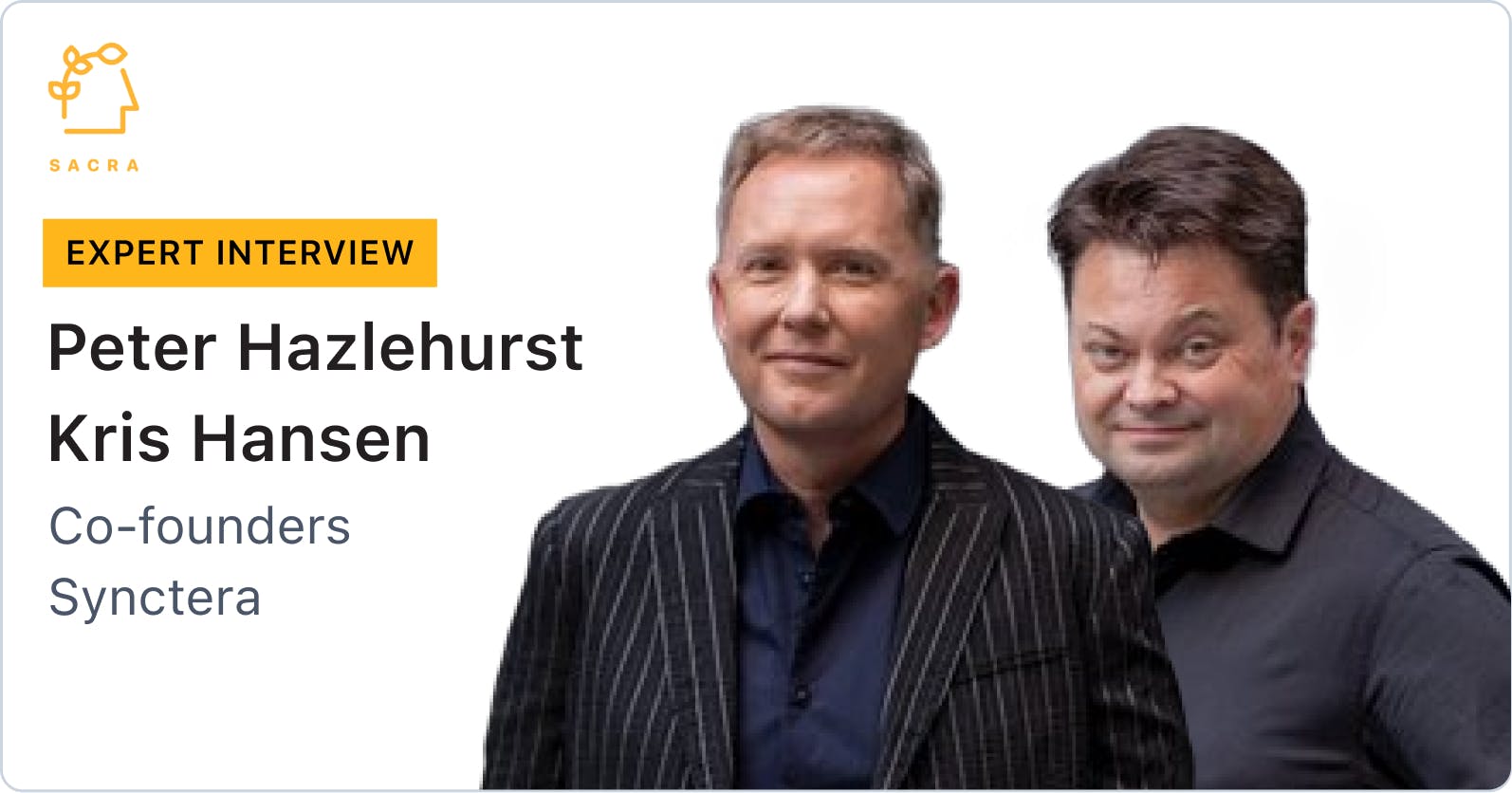Peter Hazlehurst, co-founder and CEO of Synctera, on matchmaking fintechs and sponsor banks
 Jan-Erik Asplund
Jan-Erik Asplund

Background
Peter Hazlehurst is the co-founder and CEO of banking-as-a-service platform Synctera. We talked with Peter to learn more about how banking-as-a-service platforms enable new fintechs like challenger neobanks to get to market faster, as well as how different BaaS platforms mediate the relationship between sponsor bank and fintech.
Questions
- What do Synctera's customers do, and what they use Synctera for?
- How much variance is there in the various capabilities of the community banks? For fintechs, is there an aspect of wanting to choose a specific bank, or is that all handled on the platform?
- How do you monetize on that? And how do you think big picture about the interchange split between the different parties?
- Do you think this interchange and revenue split will shift over time, or is it fairly stable?
- One thing we’ve heard is that a lot of the business model here is finding the next place out on the risk curve where you feel comfortable opening up some new service or some new speed to market. What’s your take on where things are going in this space, as it relates to community banks’ risk tolerances and what kinds of services and speeds to market are available?
- Even though they're above $10 billion in assets, it's still advantageous for them?
- We classify fintechs separately from embedded finance companies. You were involved with Uber Money, which I think of as a good prototype of modern embedded finance. Do you have any thoughts on this dichotomy? Do you think one has a bigger growth runway, better economics, etc.?
- How do you think about Synctera’s positioning versus other players, like Bond, Unit and Treasury Prime?
- As we talked about before, the community banks are the arbiters of a lot of the timing. When you talk about “really short time to market,” is that a function of having more than one community bank that you're working with?
Interview
What do Synctera's customers do, and what they use Synctera for?
Because we're a two-sided marketplace, we have two types of customers. Technically, our buyer is a community bank who wants to get into the fintech business and wants to take their precious asset -- which is their license -- and find a way to work with fintechs to create more value.
As a retail bank, you've got a retail part of the bank with consumers walking over to the branch, and you most likely have a commercial part or a small business part of the bank where you're taking those deposits the consumers dropped off and turning them into loans for the local pizza shop, things like that. If you're a growing bank, you might even have a wealth team for consumers that have some sort of investing needs.
We are proposing and have started to see a bunch of banks thinking about having a fintech division or group. While the customers themselves technically and legally belong to the bank, for all intents and purposes the end users belong to the fintech. Those fintechs are the classic neobanks that are popping up in every vector of society, whether they are neobanks for people that love pets or small business neobanks, like people that are helping stylists manage their money better and being distributed through hairstyle salon software. There's also a number of fintechs looking at the remittances business, both sending money to Africa and LatAm and stuff like that, but also reverse remittances -- we've got three separate fintechs that we're working with right now that are Indian-based and are solving money flow to folks in the US. And that doesn’t even include the tens of thousands of new immigrants coming to America every year who quickly find a problem: they can't get a bank account because they don't have previous banking records and/or they want to send money overseas. The banking use-cases are endless.
Going back into micro level-detail of the large US banking economy: you’re a small, local community bank, you basically don't know anything about any of this stuff. You’ve heard about it, and said, "that would be a cool market we could help if we could get it," but you don't know how to do it. You don't know what you have to do from a compliance perspective. You generally don't have any tech resources at all.
Our solution to the banks is, effectively, fintech-as-a-service in a box that they can acquire from Synctera at no cost. We don't charge them anything for it, and we give them a set of APIs that they in turn can offer to the fintechs that allows the fintechs to build whatever they want to build. Technically, the fintech is on the other side of the marketplace. It's all sitting on our platform, and they code to our APIs, which are sold to them by the bank. That's the true marketplace dynamic.
Here’s an analogy: think of the fintechs like riders on Uber and the banks like drivers. Our job is to help the drivers -- in this case, the banks -- have a viable platform: How do they do compliance? How do they do billing? How do they track users for KYC? All of those things, so that they keep the banks safe with the least amount of friction or integration. We don't do any connect at all to their core banking system, which means they don't have to talk to the Fiservs and the FISs to get to launch.
On the other side of the marketplace, it's all the APIs needed by the neobanks, crypto wallets and remittance companies to build their service, whether it's doing KYC, sending a transaction over ACH or push-to-card, a ledger, printing a debit card or, in the future, lending products like overdraft, line of credit, credit card and so forth.
So, a long answer to say two types of customers, broadly. A platform for banks to become entrants in the marketplace -- we've already signed seven in the six months we've been in the market. On the fintech side, we're up to twenty fintech that have signed on and are in various stages of implementation. The first of them is live now. We've built, over time, the full stack of consumer bank functionality and all the bank operations capabilities.
How much variance is there in the various capabilities of the community banks? For fintechs, is there an aspect of wanting to choose a specific bank, or is that all handled on the platform?
The different banks will have different risk tolerances. That's the primary difference between them. Some of them are quite small, so they'll have smaller balance sheets, which means it's harder for them to do lending, but you can also offload the lending balance sheet to someone else or the fintech will bring their own lender.
In general, we need banks that will do the classic neobank -- pet bank is the perfect example for people that love pets -- and we also need someone that will do remittances. Not all of our banks will do that because they say, "I don't want to deal with the KYC risk and the fraud." Very few banks will do cannabis or crypto, but we’ve found bank partners that are interested in those areas operating on our platform today. Our job is to basically think of all the possible use cases of the fintech and make sure we have at least two or three banks on the other side that can do the same service or are interested in supporting that use case.
When we come to the fintech, we say: “Okay, we've pitched you to the banks on the platform. We do the matchmaking. And here are two offers with different pricing considerations, different compliance considerations, different timing considerations. This bank says they'll bank you, even though you're doing remittances, but it's going to be really expensive on KYC. And this bank says, ‘We'll let you do remittances, but we're going to take six months to do a compliance review.’ Which one do you want? Do you want to launch tomorrow, or do you want to wait for six months?”
That's the matchmaking process. We do a bunch of due diligence on the fintech, help them get ready, build their app, test out what they're doing and then help them pitch to the banks, so they don't have to do that themselves.
How do you monetize on that? And how do you think big picture about the interchange split between the different parties?
The way you should think about it is: we provide a platform that allows the bank to offer the line of business, and for all the dollars earned by that line of business, we split the profits 50/50 with the bank.
Take, for example, the simple use case of rev share on interchange. The traditional rev share on interchange starts at about 70/30 to the fintech, meaning 100 bps to the fintech and 40 bps to the bank. That could go as high as 80/20 or, in some extreme cases, 90/10 to the fintech. We then take half of the interchange that's earned by the bank as our share of the service. For the banks, when they first launch, they say, "Hang on. That seems like you're taking margin away from us." But the second part of that is, "Okay, if we didn't have this, we'd have to build all this infrastructure. We'd have to build reconciliation billing and all of this capability just for that."
We turn around and we also say, "Well, all the fintechs need a ledger, and the ledger traditionally has been a cost to the bank." Every time you add a customer, it adds it in Fiserv or FIS, Fiserv or FIS charges the bank a dollar, and the bank tends to pass through that cost to the fintech or eat it out of its rev share on interchange. In our case, we built a ledger from scratch, and we give it to the banks for free. They mark it up to 50 or 75 cents, so now you're getting new revenue of 25 to 50 cents per user per month in free money to the bank.
Think of that across every vector of the services that a fintech would buy. KYC: market price is $1.50, wholesale cost price to us is about 70 cents, so there's about 80 cents that we rev share with the bank 50/50. The banks can get aggressive. They can price wherever they want. They could charge a dollar if they want to really own a KYC deal. Or they might want to lose margin on KYC and make more money on rev share on interchange. Or if it's just a savings account, there's no interchange at all, so then they might charge more for the ledger or something like that.
Fraud-as-a-service: all fintechs need it. All the banks require them to do it. Most fintechs don't have a clue about what to do, and no bank will approve the fintech saying, "I'm going to do it myself with my own system." Then they're paying for Riskified or one of the other vendors. In our case, it's included in the service. They can get it from us, and we charge four cents per transaction, which we split with the bank 50/50.
All of that combines to a net value prop that the bank will make 2x to 3x as much money in the total deal -- even by splitting the rev share on interchange with us -- than they would have if they were just in the business by themselves. Plus they couldn't even get into the business by themselves because they don't have the tech resources. It’s hard to build something quickly that can beat what we’ve built.
Do you think this interchange and revenue split will shift over time, or is it fairly stable?
I think the interchange splits over time will get to an equilibrium, something like 85/15 in percentage share between the banks and the fintechs, or the fintechs and the banks, depending on how you do the math.
Over time there'll be an equilibrium on the price of components, and because we've got a marketplace dynamic, the fintech is always going to get the best price from us because they're going to have banks competing across these different vectors, and/or they will get the fastest time to market because there'll be a bank that will do it at any price. Early-stage fintechs really don't care about price, they care more about: Can they launch? Can they get user signal, because they need to launch and get to their Series A or Series B? Our marketplace dynamic, on a price basis, ensures fastest time to market and best price for the FinTech.
For the bank, it's deal flow. They don't do any work. We've got two or three fintechs a day pinging us and saying, "Hey, do you have a bank? We need to launch."
One thing we’ve heard is that a lot of the business model here is finding the next place out on the risk curve where you feel comfortable opening up some new service or some new speed to market. What’s your take on where things are going in this space, as it relates to community banks’ risk tolerances and what kinds of services and speeds to market are available?
One way to think of it is the consumer journey. Take the pet bank as an example. The pet bank use case is pretty easy: it’s a debit card for consumers. That's pretty straightforward. The inverse of the pet bank is the vet, and they need small business banking. If you had them together, you could do pet-to-pet or pet-to-owner transfers, stuff like that, so you'd have P2P on the platform.
For us, our evolution has been: follow the consumer first, then the small businesses with whom they communicate, and then the natural next extension is lending. Lending takes a couple of forms.
There's not-real lending called “overdraft,” which is needed, that’s Chime’s “Spot Me”, and we had that Uber Money as a way to fund a deposit account when your account balance is low. There are lots of alternative use cases for overdraft. We've got a number of fintechs, for example, that are doing solutions for truck drivers. The truck driver wants a bank account: they know they're going to get paid at the end of the week, but they need $500 during the week for gas, and someone has to pay for that. With an extended overdraft, they can go negative, and they know they'll get topped up on the other side. We have a number of use cases like that, invoice acceleration and so forth.
The extension of that is true line of credit, where there’s a pool of funds that you can pull in or pull out. You see that with the likes of One Finance, where it's not really a credit card -- it's actually a debit card -- but it has a line of credit. That's another way of building credit profiles. There are a number of fintechs helping people establish credit by using a line of credit from which they report status of repayment.
Then secured credit and credit cards are what every fintech who services millennials is realizing is the next big thing. Most of these millennials at some point say, "I really want to buy a house or a car or whatever," and discover that, without credit, they can't. It's not because they couldn't get credit before, they just never needed it or never wanted it. We had this situation at Uber, where the majority of the usage in the US was debit card. Even if you pitched them a credit card, they'd all come in with FICO score zero. Not because they were bad people or anything, they just literally had never done credit before. They might spend a thousand bucks a month on Uber and still have a FICO score of zero, so you'd be like, "How do you pitch a classic credit card to them?" You can't.
Secured credit becomes the next extension. For many of the community banks, they're quite comfortable in that space. They get a little scared about consumer credit. They’re totally indexed towards small business credit because they do it, that's their business, that's what most community banks are: take deposits from the consumer, lend it out to the local small businesses. They're comfortable there.
Investing will be the next big chunk of stuff after credit: taking robo trading, for lack of a better term, into mass market, meaning in every vertical, so that pet bank customer also gets a high yield savings account for all intents and purposes.
Then last but not least will be insurance. Insurance is the hardest one because it's so much variance, so much delta and so much risk, and very few of the community banks will support that. In our model, what we do is pass off that capability to a big insurance company, and we'll do the stitching for the fintech. The fintech will say, "Hey, I want to sell you car insurance or property insurance or whatever." We'll do the API work to connect to State Farm or Allstate, and that will bridge the community bank's interest.
I think it's an evolving space. The interesting thing about the small business use case is you don't have to be a community bank to be competitive. The regional banks and the bigger banks are coming to us now, too, and saying, "Hey, we'll be the bank of record for your small business customers.” Because 240 bps of interchange is not subject to Durbin, so it doesn't matter, which is really important.
Even though they're above $10 billion in assets, it's still advantageous for them?
They're above that, but in small business debit card and commercial debit BINs, they pay 240 bps. They're not subject to Durbin, which means they can be competitive. So they're suddenly saying, "Okay, well, the thing we actually want is lending." Every bank at the moment is flush with deposits from all of the stimulus work that's happened through COVID, so they don't have the deposit problem that they used to have. Now we're helping them out with avenues to do lending, which is classic -- it's what they like to do. It’s actually quite interesting.
We classify fintechs separately from embedded finance companies. You were involved with Uber Money, which I think of as a good prototype of modern embedded finance. Do you have any thoughts on this dichotomy? Do you think one has a bigger growth runway, better economics, etc.?
I think the thing that's going to help a fintech win, whether they're embedded or otherwise, is if they have a legit franchise of consumers with whom they are associated. That could be Daylight with an amazing traction in the LGBTQX community, where they've basically built this amazing thing where they can decide whether the restaurant you're going to has a good reputation based on friendliness to LGBTQX. They've created a niche which is really relevant, and they can attract customers.
At Uber, we had a franchise, which was that we already had a million and a half drivers in the US, and it was worth it to us to be able to continue to support them and help them in their financial lives, because if we did, there'd be less need for them to go and get a second job or work on another platform or whatever. It was really interesting. Twenty percent of the dollars coming into that debit card didn't even come from Uber. They actually came from other gig- or non-gig jobs. The drivers had realized that a better banking product at Uber, even when working for competitors, was worth it to go and change their account on file at the other gig economy places they were working at.
It comes down to franchise. Let’s take an example of someone like StyleSeat, which is an amazing stylist operator platform. They have an amazing community of a million folks plus, whom they can offer banking services to. That gives them an easy traction point. They aren’t doing it now (that I can tell), but it would be something great to do.
I think the harder part is if you want to be a general purpose fintech, where you're saying, "I'm supporting everybody." When you're supporting everyone, you're effectively Bank of America or Chase or Citi, and what Bank of America, Chase, and Citi stopped doing -- which they used to be really good at -- was narrow-focused cards and products. All of them used to have student cards. All of them used to have bank accounts for sports players and affinity-based programs, and then they went really generic. Now they're going back to that model, but it's hard for them to do it. What they have is the flexibility of the product portfolios to take that deposit customer and say, "Yeah, of course, we've got a credit card for you. You want to step up to investing? We've got two versions of that."
I think it comes down to community, and it comes down to the really well-funded folks like Step or Greenlight who have gone really effectively into the consumer space for kids and for parent banking, stuff like that. Once they've got the toehold in there, they can afford to spend the dollars on cap to keep the customer funnel going. It remains to be seen how those folks graduate and maintain the relationship.
As you may remember in the 90s and the 2000s, it was super popular for the big card issuers -- the Chases and the Capital Ones and others -- to be on university campuses saying, "Get your first credit card from us." They were aggressive in their marketing campaigns, and the government said, "You shouldn't do that." But the reason they did it is because once you get that first relationship, it tends to stick, even if you've got all these other possibilities. What we don't know yet, as an industry, is if you will stay a long-term user of services like Chime over your lifetime, because the services are too new. Innovation is on their side, and I expect they will do a great job keeping customers on their platform through their first loan to a mortgage etc. Obviously, Chime is demonstrating lots of traction and adding more and more products to continue to be more relevant -- shared accounts, family accounts, discounts, loyalty, and so forth -- but fundamentally I think it comes down to a sense of community that they and others are building.
There are a couple of neobanks that are launching right now for YouTube creators. There's a huge community of YouTube creators, but each of them is going to win if they get MrBeast or someone like that to be their supporter. MrBeast, when he did a replay of Squid Game, he got a hundred million views -- you're just like, "Okay, this is insane." Imagine if he was monetizing that and saying, "Hey, get my MrBeast debit card." It's legit, he would get a million users in two seconds, especially if he did all of his rewards payouts through his debit card -- which reminds me, I should go and text him and see if we can get a deal.
How do you think about Synctera’s positioning versus other players, like Bond, Unit and Treasury Prime?
I think some of the key value props that we offer to the fintech are really short time to market and a flexible set of banks with whom you sign a direct relationship. Unlike the other folks, where you sign a relationship with Bond or Synapse, at the endgame you're actually getting a relationship with a bank that you get to maintain over time. Both banks and fintechs that we talk to fundamentally want that, because when there's a question of fraud -- which there will always be -- or of compliance rules, having your own relationship with the bank, such that you can say, "Look, if we need to, we'll put another reserve account on file,” and it's not disintermediated by the platform that you're talking to, is a highly valuable thing.
I think we've done a really good job of getting the zeitgeist of developers, and that's being really quick to market. We're spending most of our time on helping developers build what they need to do. For example, we just launched this new program called Ground Control, which basically says, "Hey, fintech developer, you don't know anything about compliance. We know you don't know anything about compliance. Here's a team that's going to sit there and do it for you for the first three to six months. We'll give it to you. We’re not even going to charge you anything. But at the end of three months you've got to get out of the training wheels and move into managing it yourself." Same thing on operations.
Most fintechs that we want to work with, that we've been talking to, they really don't know anything about banking. What they know about is their community. What we want to surround them with is a go-to-market that helps them understand all of those things together in one go, because they will be more successful and they'll get better banking relationships if they don't screw up an ACH file that gets dropped off at the wrong time, things like that.
As we talked about before, the community banks are the arbiters of a lot of the timing. When you talk about “really short time to market,” is that a function of having more than one community bank that you're working with?
Fundamentally, the game is about supply. There are 10x or 15x more fintechs than there are bank slots available for launch. By getting seven banks up and running, hopefully by March/April timeframe, we'll be able to do seven to ten -- maybe fifteen -- fintechs a month at launch, which is a huge opportunity for the fintechs. They know they can build on us and be guaranteed a slot to launch within two to three months. They'll build, and there'll be an endpoint for them.
The other thing that we're doing, which is really unique, is with our t-minus10 project that we're launching in January. We're effectively launching a place where there's a live sandbox. Think of it a little bit like Brex. You’re a fintech -- a pet bank -- and you want to get started. You onboard as a customer of our fintech called t-minus10. You do KYC, you deposit $50, and at that point, we give you live API keys. You can then build your app, test and print real debit cards and go to market and test the first 25 employees, that sort of thing.
It solves the conundrum for most of the fintechs that are very early, which is they want to raise money, but investors are savvy and they're saying, "We're not going to invest in you if you don't have a bank,” and the banks are savvy and they're saying, "We're not going to bank you if you don't have an investor." So they can't actually test anything with real humans. By doing this, not only do they do the normal development and go really fast, but then at the end of it, they've graduated, and we have banks lined up to say, "If you make it through t-minus10, we'll bank you no matter what."
It's a combination of that and a focus on really helping understand, from a builder's perspective, what it takes to actually launch. We've stacked the team -- myself, Kris and Dominik -- with folks that have actually built fintechs before at various stages and forms and built APIs before. I ran Yodlee for seven years on the tech and product side, and we created account aggregation, we created account verification, we created personal finance -- all those things that everyone takes for granted now with Plaid and others. It takes a certain thinking about what does a developer want in order to scale that to hundreds, if not thousands, of developers.
Disclaimers
This transcript is for information purposes only and does not constitute advice of any type or trade recommendation and should not form the basis of any investment decision. Sacra accepts no liability for the transcript or for any errors, omissions or inaccuracies in respect of it. The views of the experts expressed in the transcript are those of the experts and they are not endorsed by, nor do they represent the opinion of Sacra. Sacra reserves all copyright, intellectual property rights in the transcript. Any modification, copying, displaying, distributing, transmitting, publishing, licensing, creating derivative works from, or selling any transcript is strictly prohibited.






